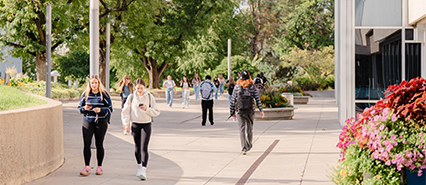Student Resources
Messages to Students
Review email communication sent to current students regarding COVID-19 and its impact to campus operations, learning, and the student experience.
CARES Act: Emergency Funding
How to Successfully Complete Your Coursework
-
Step 1. Take Charge of your Classes
When you are in classrooms at CSU Pueblo, your professors and peers help shape the structure and learning context for your class.
Now that classes have moved to a distance format, Blackboard and other online learning environments will provide much of the structure for the class and you may find yourself working more independently than you did in the classroom. These changes in course format will require that you become more proactive.
-
Step 2. Get to know how the course is organized
Chances are that each professor will be using Blackboard in different ways. Some faculty will be organizing content by modules, others will be using Blackboard as a "base camp" and linking to outside resources, and others will be posting course content without organization.
To get a sense of the structure, you might ask:
- Will the class meet at a set time?
- Where is the course content: readings/lectures/images/videos/sound recordings?
- How will you be participating in the class: synchronously (real-time) or asynchronously (discussion boards; uploading papers audio and video files; quizzes)?
- What synchronous platform will be used (Zoom, other video)?
- When are assignments due and how do you submit them?
- How will professors be communicating important information?
- Who else is in the class and how will you stay in communication?
-
Step 3. Assess your technology
We understand that not all students will have access to the same reliable technology and connectivity. Stay in constant contact with your professor and update them on your status.
-
Step 4. Manage your time, space, attention, and learning
As a CSU Pueblo student, you are used to classes meeting for an hour (or hour and a half) two to three times a week and completing work and listening to lectures during set times.
But in a distance format, you will be responsible for completing much of the work that you would have completed in class on your own or working remotely with a small group. This shift might require different study strategies.
You will want to identify a place to work, create a schedule, manage your attention, and continuously evaluate your learning.
Identify a space
Find a dedicated space that you designate as your classroom and create an environment where you can focus.
Create a schedule
You are not in a CSU Pueblo rhythm - and you cannot really leave the house - you will have far more unstructured time. This can be dangerous! Make a schedule and commit to it.
- Get the Lay of the Land - Look at your courses and map out due dates. Identify when you are in "class". Note homework loads and daily coursework.
- Build a Daily Schedule - Build your daily schedule around your “class†time. If all or part of your instruction is asynchronous, you still want to decide on when you are in class and stick to it. Budget at least 6 hours of class time a day.
- Check and Plan - Plan to check on all of your classes everyday, even if you are not "meeting". Note what is and is not working for you in each class. Revise your daily schedule as necessary.
Manage your attention
When you are sitting in a classroom, you experience a certain amount of social pressure to demonstrate you are paying attention. Sitting at home, you might feel yourself tempted by any number of distractions. You might even kid yourself that you can multitask. When you attempt to multitask:
- Your assignments take more time to complete
- You are more likely to make mistakes
- You will remember less of what you have learned
When you are "in class", close all windows in your browser except Blackboard, disable your email and chats, hide your phone, and ask your friends and family for some privacy.
Evaluate daily what you know and what you do not know
In a distance format, you will not have the immediate feedback from your professor and peers on your learning. Take a step back every day and evaluate what you know and don't understand. Ask yourself questions like:
- What was the most important insight that I gained?
- How do I approach assignments to be more successful?
- What kinds of problems keep tripping me up?
- How is my study schedule working? Am I giving myself enough time?
-
Step 5. Embrace Video Lectures and Discussion Boards
To get the most out of this type of lecture:
- Prepare - Complete the readings first to draw upon the base of knowledge to enhance your understanding.
- Take Notes - You might think you don't need to because you can refer back to the lectures, but taking notes will help you focus on the material
- Stop and Review - Stop the lecture periodically throughout the lecture (every 5-10 min) and write down everything you can remember. Go back and listen for critical details you might have missed.
- Integrate - Bring your notes and summaries together for each lecture.
- Make Resources for Studying - Outlines, flash cards, possible quiz questions, etc.
Discussion Boards
Working in a distance format with discussions can be very different than in-class discussions. Specifically, your professor might ask you to contribute to class through posts to discussion boards. To be successful in this new format, you will want to:
- Understand the expectations and ground rules for the discussion board. Review your syllabus, ask your professor about the type of content expected, think about "netticut" in your posts and how you respond to others, and how your posts may be used in your final grade.
- Read others' comments before posting. Connect your ideas to others.
- Make sure your posts are clear and well-structured. Take time to clarify the message and organize your thoughts in concise paragraphs.
- Respond to others' posts in supportive and challenging ways. Be sure your posts are respectful, positive in tone, and do not appear angry, even when you disagree or want to present an alternative viewpoint.
- Use language that is appropriate for an academic environment. Avoid writing in a way that is too informal (i.e., writing that resembles text messages)
-
Step 6. Build a Community Online
At CSU Pueblo, you are used to spending a lot of time with your professors and peers in class and on campus. The time you spend in class and on campus fosters close relationships that are motivating for learning.
You can still develop close relationships in a distance format, but you may need to be more intentional about reaching out to your professor and other students in class. Please have at least one direct exchange with your professor or classmates everyday with emails, chat, discussion boards, or synchronous discussions.
Connect with a Tutor/Mentor
Connect with a CSU Pueblo Peer Mentor to discuss tutoring services, learning at a distance format, best practices, and more!
Registration and Advising
The Pack Center is ready to conduct advising sessions with you in person or via video or phone.
Disability Services
Students who need accessibility accommodations because of instructional shifts to distance learning should contact the Disability Resource and Support Center.


